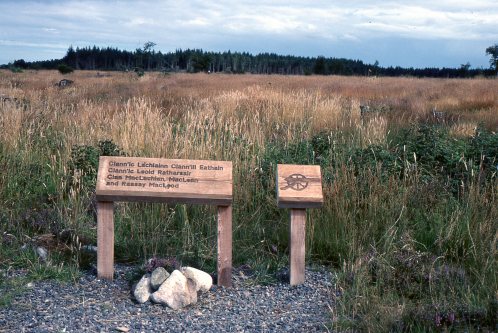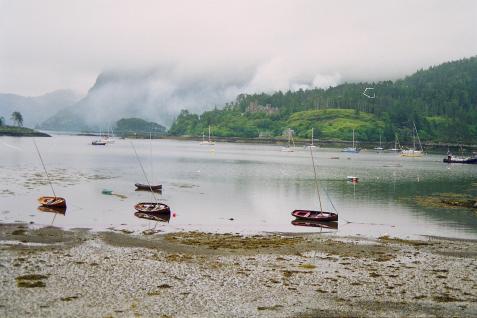Leaving Skye in 1996 we did a typically Australian thing to do: we drove to Aberdeen in a day! The locals all thought we were mad.
But before we go to Aberdeen we have to visit Plockton, the ancestral home of my husband’s family. My husband’s grandfather left home at the age of 14 to go to sea, and ended up in South Australia. Plockton was, historically, a fishing village. These days, apparently, there are few of the original descendants, but rather it has become popular with “incomers” such as artists and writers. We had afternoon tea with a local historian who turned out to be wintering in Plockton from his usual residence in Stornoway on the Isle of Lewis. Even the historian wasn’t local!
It is no wonder Plockton has become popular with artists; it is such a gorgeous place. Whitewashed cottages spread along the shore of Loch Carron with views out to the mountains of the Applecross Peninsula give it a charm you wouldn’t normally associate with a remote fishing village. In winter, the snow-capped mountains just add another dimension to the beauty. A walk up the hill overlooking the village allows a magnificent view of the village, loch and mountains. Truly breathtaking.
I have just discovered that you can go sea kayaking at Plockton – time for another trip!
“All age groups will be amazed at the breathtaking panoramic views of the Isle of Skye, Applecross and Torridon mountains and the adventure of reaching coral beaches only accessible by boat. Paddling over the clear waters around Plockton will enable young and old to appreciate the marine life below.” http://www.seakayakplockton.co.uk
For those of you who enjoyed the television series Hamish Macbeth, starring Robert Carlyle, you may be interested to know that the village of Loch Dubh in the series was actually Plockton. On one of our visits the side of the pub still had the sign ‘Loch Dubh’ painted on its wall.
Now we can go to Aberdeen. Due to the distance, we entered Aberdeen at night. It was late November and the streets were strikingly decorated with lights depicting the Twelve Days of Christmas. In addition, many of Aberdeen’s significant buildings are illuminated by spotlights, producing a dramatically beautiful effect. Aberdeen is a very attractive city in the daylight too.
My husband decided that the thing to do in Aberdeen was to go down to the docks at the crack of dawn and watch the local fishermen bring in their catch. Needless to say, that on a cold winter’s morn the kids and I opted to stay in bed! He returned waxing lyrical about how exciting the experience had been and the varieties of fish that we don’t see in Australia. So; if you’re a keen fisherman, or just up for something exotic, try the fish market.
Aberdeen is naturally a grey city as it is constructed, predominantly, from granite. Winter just adds drabness to the grey, although, to be fair, the spot-lit buildings and the fantastic Christmas lights went a long way to alleviate this. To truly escape the winter grey though, visit the Winter Gardens at Duthie Park. Housed in a huge greenhouse are colourful, tropical plants including bougainvillea, bromeliads and cacti. It is really beautiful – and warm.
Culloden, near Inverness, is the site of the famous battle which occurred in 1746 during the Jacobite uprisings.
“Following his victory at Culloden, the Duke of Cumberland was determined to eliminate the Jacobite threat once and for all. He wanted revenge: his army would crush the unruly Highlands, capture the Prince, and return to the main war in Flanders as soon as possible. There was to be no question of a further rebellion.
Within a few days of the battle, around 1,500 Jacobite soldiers gathered at Ruthven Barracks, ready to continue the campaign. To their surprise Prince Charles gave the order to disperse and then went into hiding. For him, the Rising was over.
Unopposed, the government sent its army and navy across Scotland, punishing anyone suspected of Jacobite sympathies. The policy of ‘pacification’ of the Highlands had begun.
The government began to dismantle the structures of Highland society. Chiefs were deprived of their legal powers and clansmen of their weapons. Jacobite estates were seized by the Crown. The kilt and tartan were banned.” http://www.nts.org.uk/Culloden/Home/
We visited Culloden in 1984 and, after a visit to the information centre (a new visitor information centre opened in 2007), my husband decided to explore the battlefield in-depth. I opted to stay in the car and, for some totally inexplicable reason, I wrote a poem!
Dark clouds were looming overhead,
The battle lines cross fields were spread.
Men marched to here from lands afar,
Imagine scenes, the shouts ‘huzzah’!
Though not for those of Highland clan,
For here was born the tartan ban.
Now honour grows for men lain here,
And tartan shows no shame or fear.
But men still come from lands abroad,
Though not this time with battle sword.
For hay across the fields is spread,
With clear skies dawning overhead.
RAM 1984

The view at Culloden that inspired the poem.






